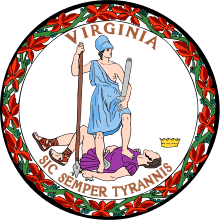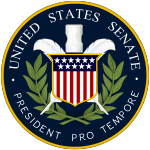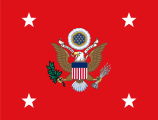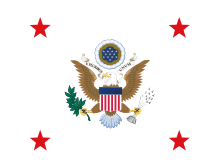James Barbour
| James Barbour | |
|---|---|
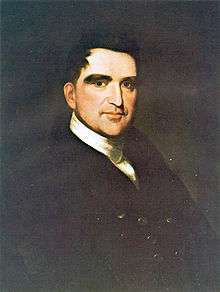 | |
| United States Minister to the United Kingdom | |
|
In office November 24, 1828 – October 1, 1829 | |
| President | John Quincy Adams |
| Preceded by | Albert Gallatin |
| Succeeded by | Louis McLane |
| 11th United States Secretary of War | |
|
In office March 7, 1825 – May 23, 1828 | |
| President | John Quincy Adams |
| Preceded by | John C. Calhoun |
| Succeeded by | Peter Buell Porter |
| 27th President pro tempore of the Senate | |
|
In office February 15, 1819 – December 26, 1819 | |
| Preceded by | John Gaillard |
| Succeeded by | John Gaillard |
| United States Senator from Virginia | |
|
In office January 2, 1815 – March 7, 1825 | |
| Preceded by | Richard Brent |
| Succeeded by | John Randolph |
| 18th Governor of Virginia | |
|
In office January 3, 1812 – December 1, 1814 | |
| Preceded by |
Peyton Randolph as Acting Governor |
| Succeeded by | Wilson Cary Nicholas |
| 14th Speaker of the Virginia House of Delegates | |
|
In office December 1, 1809 – January 3, 1812 | |
| Preceded by | Hugh Nelson |
| Succeeded by | Andrew Stevenson |
| Member of the Virginia House of Delegates | |
|
In office 1804 1807-1812 | |
| Personal details | |
| Born |
June 10, 1775 Barboursville, Virginia |
| Died |
June 7, 1842 (aged 66) Barboursville, Virginia, U.S. |
| Political party |
Whig National Republican Democratic-Republican |
| Spouse(s) | Lucy Johnson Barbour |
| Profession | Lawyer, Politician |
| Religion | Presbyterian |
| Signature |
|
James Barbour (June 10, 1775 - June 7, 1842) was an American lawyer, a member and speaker of the Virginia House of Delegates, the 18th Governor of Virginia, the first Governor to reside in the current Virginia Governor's Mansion, a U.S. Senator from 1814–1825, and the United States Secretary of War from 1825-1828.
Barbour was a renowned statesman and orator. His abilities to persuade by speech were noted by several of his peers, including John Quincy Adams. Barboursville, Virginia located in Orange County was named after James Barbour. The ruin of Barbour's mansion, Barboursville, is listed on the National Register of Historic Places and can be found on the grounds of Barboursville Vineyards in the Madison-Barbour Rural Historic District in Barboursville, Virginia. The mansion was designed by James Barbour's friend, Thomas Jefferson. Barbour County, Alabama is named in his honor. Barbour County in West Virginia, as well as Barbourville, Kentucky and Barboursville, West Virginia are all named in honor of James Barbour. He was the brother of Philip Pendleton Barbour, as Speaker of the United States House of Representatives and Associate Justice of the Supreme Court as well as the first cousin of John S. Barbour and first cousin, once removed of John S. Barbour, Jr..
Early years
James Barbour was born in Barboursville, Virginia in Orange County on June 10, 1775. Barbour was the son of Thomas Barbour, who held a seat in the Virginia House of Burgesses, and Mary Pendleton Thomas, both of Orange County, Virginia. His family was one of the first to settle in Orange County, which proved to be lucrative for the family. By the time of James’s birth, the Barbour family owned over 2,000 acres (8 km²) and held several slaves. Much of that wealth, however, dissipated before James could acquire a formal education. James was educated, in part, at Gordonsville, Virginia by James Waddell. He served as deputy sheriff of Orange County, beginning in 1792. Shortly thereafter, in 1794, he was admitted to the Virginia Bar. On October 29, 1792, Barbour married Lucy Johnson, who was the daughter of Benjamin Johnson who served in the House of Burgesses. With wedding gifts from his father, James was able to slowly acquire his own personal wealth. By 1798, he owned several slaves and was prepared to begin his own plantation.
House of Delegates
Barbour was elected to the Virginia House of Delegates in 1796, serving until 1804, and again from 1807 to 1812.[1] He was the youngest member of the House. During his tenure, Barbour was known for his eloquent speech. He served on many committees in the House and even as chairman on several committees, including the Committee of Privileges and Elections and the Finance Committee. He held the role of Speaker of the House of Delegates – a seat he held for many terms.
During these years, Barbour held strong to his Virginian Republican beliefs. He vigorously opposed the Alien and Sedition Acts of 1798 and used his known skills in rhetoric to support the Virginia Resolutions. Barbour believed the Acts and their supporters to be a threat to the United States, stating “to make an expected attack from abroad a pretext for attacking the principles of liberty at home has drawn aside the curtain and clearly illuminated for all who are willing to see.” Holding strong to the ideals on which the U.S. was formed, Barbour refused to support any act he believed to give the Executive unchecked powers.
Among his acts in the House of Delegates, Barbour believed his greatest to be the Act which provided for the Literary Fund of Virginia. The Act, passed on February 2, 1810, provided funding for public education in each county in the Commonwealth. Barbour strongly believed society would progress only through education. Barbour later requested that the only inscription on his tombstone be a reference to this Act. Like many of his time, Barbour was a figure who to the modern mind appears conflicted, if not hypocritical. While believing society could progress through education, he also believed intellectual abilities were connected with landownership.
Governor of Virginia
In 1811, Barbour declared his candidacy for the governorship. However, Barbour lost to the incumbent governor, George William Smith. On December 26, 1811, Smith died in a fire at the Richmond Theatre. On January 3, the Legislature convened and appointed Barbour governor. At the time, the country was on the verge of war with Britain. Barbour was in favor of the war, which he viewed as the only means by which to end British interference with the sovereignty of the U.S. As such, he began preparing the state for war. Barbour, whose father had trained the Orange militia, was aware of the inadequacies of Virginia’s militia. Accordingly, he sought appropriations for training and arming a stronger militia on February 11, 1812. Barbour urged the commanders of the militias from each county to prepare for defense of the country. He personally toured the tidewater region, which offered safe harbors for a British invasion. All of these acts earned Barbour the title of “the war governor.”
On June 18, 1812, Congress declared war. So began the War of 1812. Perhaps because of his preparation for war, Barbour was reelected Governor in November 1812 without opposition. However, by 1813, Barbour was opposed by those who believed his strong policies of national unity were detrimental. Again, Barbour was elected governor. During this final term in 1814, Barbour finally convinced the Legislature to approve a plan of organizing 10,000 troops to be selected for a militia under Federal control. However, the Treaty of Ghent brought the war to an end. Barbour’s governorship also included many other acts, including exploration of the upper James River. He received funding to improve the roads of Virginia. He was also the first Governor to inhabit the Virginia Governor’s Mansion, designed by Alexander Parris.
His contemporaries praised Barbour for his leadership. Barbour was viewed as an effective leader, whose executive powers, while stronger and more coherent than many of his predecessors, were adequately utilized to protect Virginia. Barbour also received the praise of the people of Virginia, who sent resolutions thanking the Governor for his strong and apt leadership during the war.
U.S. Senator
On December 1, 1814, the Legislature of Virginia voted to appoint Barbour as the successor to Richard Brent (Virginia) to the United States Senate. Barbour, who had previously opposed its formation, now voted in favor of a national Bank. Bill after bill failed to pass or survive veto. President James Madison, fearing bankruptcy, sought the assistance of his friend, James Barbour. Barbour introduced into the Senate a bill composed by Secretary of the Treasury Alexander James Dallas. This Bill, calling for $50,000,000 in capital, passed. Interestingly, Barbour served in the Senate contemporaneously with his brother Philip Pendleton Barbour, who served in the House. Often, their votes opposed each other, as Barbour began to vote in line with Senators such as John C. Calhoun and Henry Clay. Barbour’s actions during his service as Senator include:
- Proposing a committee on roads and canals
- Advocating of the Bonus Bill (authorizing spending the bonus from the bank on improvements)
- Proposing a constitutional amendment granting Congress authority to appropriate money for improvements
- Opposing efforts to reduce the national army, supporting a bill abolishing imprisonment of debtors, and introducing the Navigation Act of 1818. The Act closed U.S. ports to any ships arriving from British ports closed to U.S. ships. Barbour hoped the Act would encourage the British to open their ports, thus promoting international trade. However, these efforts failed. Finally, a compromise was reached in 1823, when the Elsewhere Act was passed allowing for reciprocal trade.
Barbour was elected President pro tempore of the Senate in 1819. The 16th Congress, over which Barbour presided, decided on the Missouri Compromise. Barbour proposed to have the bill admitting Missouri combined with the bill admitting Maine in an attempt to deny the Northern Senators an opportunity to gain 4 anti-slavery Senators. The proposal was accepted. Barbour’s speech focused on the rights of the people of Missouri to decide for themselves whether to be a free or slave state. Perhaps foreseeing the future or perhaps merely engaging in his verbose nature, Barbour stated,
| “ | Sir, no portion of the Union has been more loyal than the South. Is this your reward for our loyalty? Sir, there is a point where resistance becomes a virtue and submission a crime. Our people are as brave as they are loyal. They can endure anything but insult. But the moment you pass that Rubicon, they will redeem their much abused character and throw back upon you your insolence and your aggression. | ” |
During his term of service, Barbour persuaded the Senate to pass a resolution giving an honorary sword to Colonel Richard Mentor Johnson of Kentucky for his efforts in the Battle of the Thames in 1813. Johnson and Barbour would become quick friends following Barbour’s efforts. This friendship proved important for Barbour, who was appointed Secretary of War by President John Quincy Adams at the behest of Johnson.
Secretary of War
Barbour was confirmed as the Secretary of War following Adams’s inauguration on March 4, 1825. The War Department’s main functions were to oversee Indian affairs and manage the army. Barbour, who came from a family of large land owners, conflicted with Governor George Troup of Georgia, as Barbour wished to have the government remove Creek Indians from 5 million acres (20,000 km²) of land. Adams signed a treaty approving the removal shortly after taking office, however, Troup convinced Adams and Congress to abrogate the treaty. Barbour was unhappy with this decision, but ultimately succeeded in purchasing most of the land very cheaply from the Creeks.
Troup tried to restore the land to the Indians, but Barbour thwarted his efforts. Troup and Adams agreed that the federal government would need to intervene, but Barbour purchased the remaining lands and prepared the Creek Indians for removal to lands west of the Mississippi. Barbour proposed setting aside lands west of the Mississippi for an Indian Territory. Those Indians who refused to move onto these lands were to be assimilated into white society. He hoped the tribal structure would dissipate, thus facilitating the incorporation of the territory into the U.S. as a state. His proposal, based on a misunderstanding of Indian culture and undoubtedly Western beliefs on the progress of civilization, failed.
Societies
During the 1820s, Barbour was a member of the prestigious society, Columbian Institute for the Promotion of Arts and Sciences, who counted among their members former presidents Andrew Jackson and John Quincy Adams and many prominent men of the day, including well-known representatives of the military, government service, medical and other professions.[2]
Final years of service
In 1826, Barbour was considered for the vice-presidential nomination in the upcoming 1828 elections. Barbour quickly opposed this. Instead, Barbour sought an appointment as Minister to England. Critics claimed Barbour was seeking a “harbor in the storm” from the approaching election. Andrew Jackson, who was anti-nationalist, opposed the ideals which Barbour supported. Barbour’s ministry was marked by acceptance into European intellectual circles. On July 1, 1828, Barbour was awarded the degree of LL.D. from the University of Oxford. After his ministry, Barbour returned to Virginia, where he announced his candidacy for the General Assembly. However, Barbour’s nationalistic policies made him unfavorable to the Virginian Republicans. The election, in which his opponent was an illiterate man, was extremely close. Barbour narrowly escaped defeat. However, after he was declared winner, the election was contested. Barbour promised to retire should it prove that he in fact had lost the election. Although no such proof was ever found, Barbour retired on February 16, 1831 due to the hostility in the Assembly against him.
Barbour continued to remain active in politics. In December 1831 he attended the first national convention of the National Republican Party in Baltimore and was made the presiding officer (called "President") of that body. The nominations made there for the coming 1832 campaign were Henry Clay for President and John Sergeant for Vice President. He also acted as chairman of the 1839 Whig Party convention.
Death
After his retirement from the Assembly, Barbour sought refuge in his family home at Barboursville. Barbour remained somewhat active in political life, making appearances and giving speeches to support his political friends. One such speech led an observer to declare “Gov. Barbour presented an imposing appearance, with striking face, long, shaggy eyebrows, and head covered with silvery flowing locks; with a majestic and sonorous voice, he filled one’s conception of a Roman Senator in the last days of the Republic.”[3] Shortly thereafter, Barbour’s health began to decline. His last months of life were spent at Barboursville. However, on June 7, 1842, surrounded by his wife and numerous children, Barbour died.
References
- ↑ http://ead.lib.virginia.edu/vivaxtf/view?docId=lva/vi00878.xml
- ↑ Rathbun, Richard. The Columbian institute for the promotion of arts and sciences: A Washington Society of 1816-1838. Bulletin of the United States National Museum, October 18, 1917. Retrieved 2010-06-20.
- ↑ Bell, John W., Memoirs of Governor William Smith of Virginia: His Political, Military and Personal History. (New York: Moss Engraving, 1891), 14.
Further reading
- Lowery, Charles; James Barbour, a Jeffersonian Republican; 1984, University of Alabama Press; (2004 paperback: ISBN 0-8173-5076-4)
- Long, William Stapleton; "James Barbour"
External links
- Archival Records
| Political offices | ||
|---|---|---|
| Preceded by Peyton Randolph Acting Governor |
Governor of Virginia January 3, 1812 – December 1, 1814 |
Succeeded by Wilson C. Nicholas |
| Preceded by John Gaillard |
President pro tempore of the United States Senate February 15, 1819 – December 26, 1819 |
Succeeded by John Gaillard |
| Preceded by John C. Calhoun |
U.S. Secretary of War Served under: John Quincy Adams March 7, 1825 – May 23, 1828 |
Succeeded by Peter B. Porter |
| United States Senate | ||
| Preceded by Richard Brent |
U.S. Senator (Class 1) from Virginia January 2, 1815 – March 7, 1825 Served alongside: William B. Giles, Armistead T. Mason, John W. Eppes, James Pleasants, John Taylor, Littleton W. Tazewell |
Succeeded by John Randolph |
| Diplomatic posts | ||
| Preceded by Albert Gallatin |
Envoy Extraordinary and Minister Plenipotentiary to Great Britain 1828–1829 |
Succeeded by Louis McLane |
